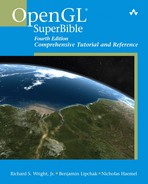Color Plate 1. (not associated with any chapter) Software Bisque’s next generation sky charting application, TheSkyX Astronomy Software, uses only OpenGL fixed pipeline rendering for increased compatibility with older 3D hardware (image courtesy of Software Bisque, Inc.).

Color Plate 2. Shaders allow for unprecedented real-time realism (image courtesy of Software Bisque, Inc.). (For Figure 1.20 in Chapter 1)

Color Plate 3. OpenGL’s imaging subset at work: color image, color negative, embossed, and grayscale conversions. (For figures in Chapter 7)

Color Plate 4. Linear filtering up close. (For Figure 8.8 in Chapter 8)

Color Plate 5. Output from the CUBEMAP sample program. (For Figure 9.11 in Chapter 9)

Color Plate 6. The Final Thunderbird model. (For Figure 11.8 in Chapter 11)

Color Plate 7. This vertex shader computes diffuse lighting. (For Figure 16.2 in Chapter 16)

Color Plate 8. This vertex shader computes diffuse and specular lighting. (For Figure 16.3 in Chapter 16)

Color Plate 9. The per-vertex specular highlight is improved by using separate specular or a specular exponent texture. (For Figure 16.4 in Chapter 16)

Color Plate 10. Three lights are better than one. (For Figure 16.5 in Chapter 16)

Color Plate 11. Applying per-vertex fog using a vertex shader. (For Figure 16.6 in Chapter 16)

Color Plate 12. Per-vertex point size makes distant points smaller. (For Figure 16.7 in Chapter 16)

Color Plate 13. This simple elbow joint without vertex blending just begs for skin. (For Figure 16.9 in Chapter 16)

Color Plate 14. The stiff two-cylinder arm is now a fun, curvy, flexible object. (For Figure 16.10 in Chapter 16)

Color Plate 15. This fragment shader performs sepia tone color conversion. (This image shows the result of Listing 17.2 in Chapter 17)

Color Plate 16. This fragment shader simulates a heat signature by looking up a color from a 1D texture. (For Figure 17.3 in Chapter 17)

Color Plate 17. This fragment shader blurs the scene. (For Figure 17.5 in Chapter 17)

Color Plate 18. This fragment shader sharpens the scene. (For Figure 17.6 in Chapter 17)

Color Plate 19. This fragment shader implements Laplacian edge detection. (For Figure 17.9 in Chapter 17)

Color Plate 20. An overhead view showing how the beachball colors are assigned. (For Figure 17.14 in Chapter 17)

Color Plate 21. You have built your own beach ball from scratch! (For Figure 17.15 in Chapter 17)

Color Plate 22. The toy ball shader describes a relatively complex shape. (For Figure 17.17 in Chapter 17)

Color Plate 23. PBOs improve the performance of our motion blur sample. (For Figure 18.2 in Chapter 18)

Color Plate 24. FBOs improve the image quality of our shadow mapping sample. (For Figure 18.3 in Chapter 18)

Color Plate 25. Render to texture with FBOs to improve performance of dynamic environment mapping. (For Figure 18.5 in Chapter 18)

Color Plate 26. Fragment shaders can simultaneously output multiple distinct colors to separate color buffers attached to FBOs. (For Figure 18.6 in Chapter 18)

Color Plate 27. Data is thrown away when colors outside [0,1] are clamped (left) rather than mapped to [0,1] (right). (For Chapter 18—not associated with any black and white figure)

Color Plate 28. The HDR image of the silhouetted tree (left) reveals surprising detail when the aperture is adjusted (right). (For Chapter 18—not associated with any black and white figure)

Color Plate 29. The still life sheds its warm candle glow (left) courtesy of a white balance tone mapping shader (right). (For Chapter 18—not associated with any black and white figure)

Color Plate 30. Bloom and afterglow effects help give the impression of extreme brightness even when we can’t display colors brighter than 100% white. (For Chapter 18—not associated with any black and white figure)

Color Plate 31. OpenGL ES rendering on a cellphone. (For Figure 22.1 in Chapter 22)

Color Plate 32. (not associated with any chapter) This scene from Software Bisque’s Seeker solar system simulator is rendered entirely with OpenGL shaders (image courtesy of Software Bisque, Inc.).

